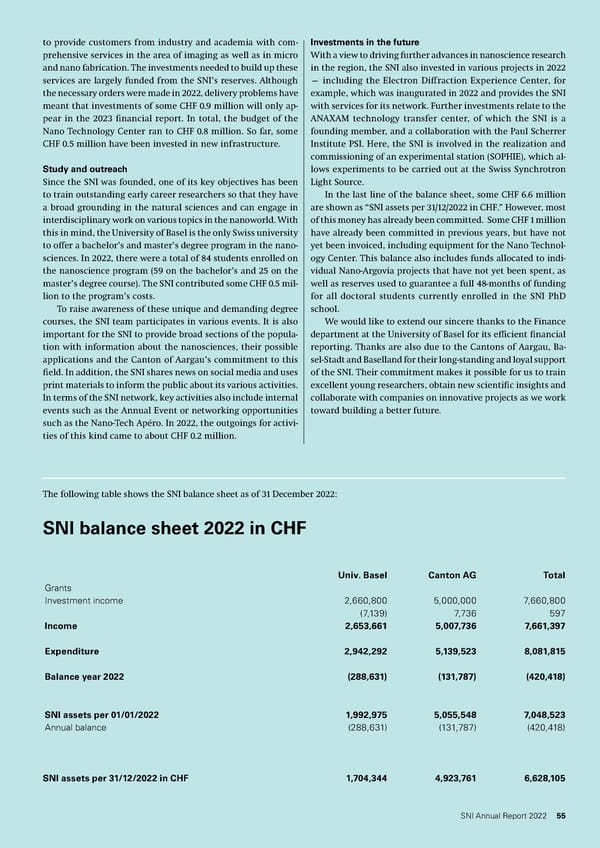to provide customers from industry and academia with com- Investments in the future prehensive services in the area of imaging as well as in micro With a view to driving further advances in nanoscience research and nano fabrication. The investments needed to build up these in the region, the SNI also invested in various projects in 2022 services are largely funded from the SNI’s reserves. Although — including the Electron Diffraction Experience Center, for the necessary orders were made in 2022, delivery problems have example, which was inaugurated in 2022 and provides the SNI meant that investments of some CHF 0.9 million will only ap- with services for its network. Further investments relate to the pear in the 2023 financial report. In total, the budget of the ANAXAM technology transfer center, of which the SNI is a Nano Technology Center ran to CHF 0.8 million. So far, some founding member, and a collaboration with the Paul Scherrer CHF 0.5 million have been invested in new infrastructure. Institute PSI. Here, the SNI is involved in the realization and commissioning of an experimental station (SOPHIE), which al- Study and outreach lows experiments to be carried out at the Swiss Synchrotron Since the SNI was founded, one of its key objectives has been Light Source. to train outstanding early career researchers so that they have In the last line of the balance sheet, some CHF 6.6 million a broad grounding in the natural sciences and can engage in are shown as “SNI assets per 31/12/2022 in CHF.” However, most interdisciplinary work on various topics in the nanoworld. With of this money has already been committed. Some CHF 1 million this in mind, the University of Basel is the only Swiss university have already been committed in previous years, but have not to offer a bachelor’s and master’s degree program in the nano- yet been invoiced, including equipment for the Nano Technol- sciences. In 2022, there were a total of 84 students enrolled on ogy Center. This balance also includes funds allocated to indi- the nanoscience program (59 on the bachelor’s and 25 on the vidual Nano-Argovia projects that have not yet been spent, as master’s degree course). The SNI contributed some CHF 0.5 mil- well as reserves used to guarantee a full 48-months of funding lion to the program’s costs. for all doctoral students currently enrolled in the SNI PhD To raise awareness of these unique and demanding degree school. courses, the SNI team participates in various events. It is also We would like to extend our sincere thanks to the Finance important for the SNI to provide broad sections of the popula- department at the University of Basel for its efficient financial tion with information about the nanosciences, their possible reporting. Thanks are also due to the Cantons of Aargau, Ba- applications and the Canton of Aargau’s commitment to this sel-Stadt and Baselland for their long-standing and loyal support field. In addition, the SNI shares news on social media and uses of the SNI. Their commitment makes it possible for us to train print materials to inform the public about its various activities. excellent young researchers, obtain new scientific insights and In terms of the SNI network, key activities also include internal collaborate with companies on innovative projects as we work events such as the Annual Event or networking opportunities toward building a better future. such as the Nano-Tech Apéro. In 2022, the outgoings for activi- ties of this kind came to about CHF 0.2 million. The following table shows the SNI balance sheet as of 31 December 2022: SNI balance sheet 2022 in CHF Univ. Basel Canton AG Total Grants Investment income 2,660,800 5,000,000 7,660,800 ( 7,139) 7,736 597 Income 2,653,661 5,007,736 7,661,397 Expenditure 2,942,292 5,139,523 8,081,815 Balance year 2022 (288,631) (131,787) (420,418) SNI assets per 01/01/2022 1,992,975 5,055,548 7,048,523 Annual balance (288,631) (131,787) (420,418) SNI assets per 31/12/2022 in CHF 1,704,344 4,923,761 6,628,105 SNI Annual Report 2022 55
 SNI Annual Report 2022 Page 54 Page 56
SNI Annual Report 2022 Page 54 Page 56